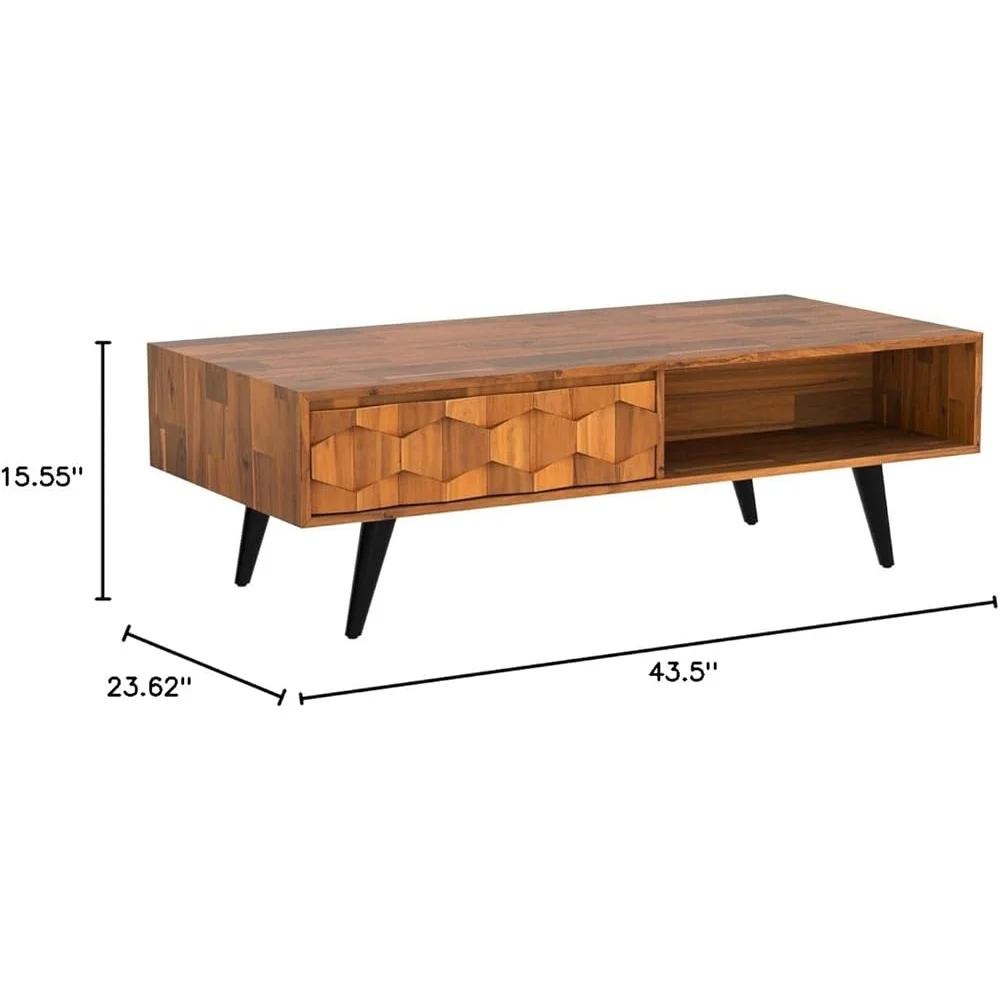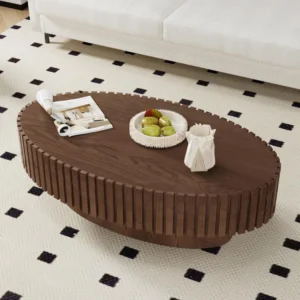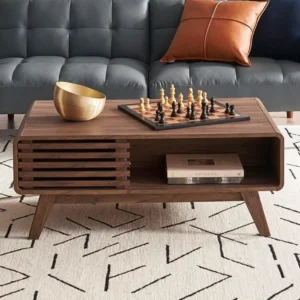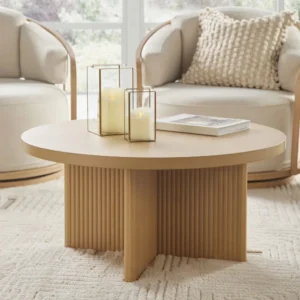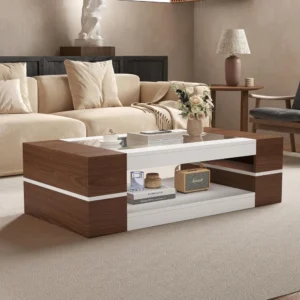Understanding Wood Grain: The Foundation of Teak Furniture Quality
Wood grain is much more than just the visible pattern on furniture—it’s the actual cellular structure of the tree, revealing how it grew year after year. In trees like teak (Tectona grandis), the grain represents the arrangement of wood fibers, growth rings, and cellular elements that developed as the tree matured in tropical forests. This natural architecture isn’t just beautiful; it’s the primary indicator of furniture quality and performance.
Teak is special among hardwoods because its grain structure contains natural oils and rubber compounds that give it exceptional resistance to moisture, insects, and decay. When evaluating teak furniture, understanding grain patterns helps you determine not just how the piece will look, but how it will perform over decades of use.
The growth conditions of teak trees—including soil quality, climate, and most importantly, age—directly influence grain formation. Premium teak develops slowly, with trees requiring at least 20-30 years to produce the tight, consistent grain patterns most valued in fine furniture. This slow growth contributes to teak’s impressive 1,000 lbf rating on the Janka Hardness Scale, making furniture crafted from quality intelligent black mid-century coffee tables both beautiful and exceptionally durable.
Throughout this guide, we’ll explore how to recognize quality grain patterns, understand their impact on furniture performance, and learn to make informed decisions when investing in teak furniture.
The Science of Teak Grain: Nature’s Quality Blueprint
Cellular Density and Grain Formation
At the microscopic level, teak’s remarkable properties come from its unique cellular structure. The density of these cells—how tightly packed they are—directly affects what we see as grain pattern. Higher-quality teak has more densely packed cells, creating tighter, more consistent grain lines that not only look more refined but provide superior strength.
Natural Oil Distribution
What truly sets teak apart is its natural oil content. These oils—primarily tectoquinones—aren’t evenly distributed throughout the tree. The heartwood (central core) contains significantly higher concentrations, which is why furniture made from heartwood displays superior resistance to moisture and pests. These oils flow through and integrate with the grain structure, creating teak’s characteristic slightly waxy feel and golden hue.
Environmental Influence on Grain Quality
Teak’s growing conditions dramatically impact its grain quality. Trees growing in optimal environments with proper seasonal variations develop more regular growth rings and consistent grain patterns. Premium teak typically comes from trees grown slowly over 20-30 years (with the finest specimens aging 35+ years), allowing time for oils to concentrate and grain patterns to stabilize.
The silica content in teak—a compound that gives the wood additional hardness—also affects grain appearance. This silica integrates within the cellular structure, following the grain lines and contributing to teak’s legendary durability.
The unique combination of these elements is why teak from different geographic origins displays distinct characteristics. The soil composition, rainfall patterns, and climate all leave their mark in the teak wood grain variations regions produce, creating subtle but important differences that furniture enthusiasts learn to recognize and appreciate.
Teak Grades and Grain Patterns: The Quality Hierarchy
Teak quality follows a standardized grading system that directly reflects grain characteristics. Understanding these grades helps you make informed furniture investments:
Grade A Teak
- Harvested from the heartwood of mature trees (35+ years old)
- Tight, straight, and consistent grain pattern
- Minimal knots and natural imperfections
- Rich golden-brown color that darkens beautifully with age
- Maximum natural oil content for superior weather resistance
- Premium pricing reflecting rarity and quality
Grade B Teak
- Typically from the outer heartwood or inner transition zones
- More varied grain pattern with occasional irregularities
- Some knots and minor imperfections present
- Lighter color with some variations
- Good but reduced natural oil content
- Mid-range pricing that balances quality and value
Grade C Teak
- Often includes sapwood (outer layers) of the tree
- Inconsistent grain with frequent irregularities
- More numerous knots and imperfections
- Lighter, more variable coloration
- Significantly lower natural oil content
- Budget-friendly pricing
The source location within the tree directly determines grain quality. Heartwood—the densest inner core—produces the straightest, most consistent grain patterns ideal for premium furniture. This is why fine mid-century modern teak coffee tables command higher prices; they require larger portions of high-grade heartwood with superior grain characteristics.
Furniture makers carefully select wood grades based on the furniture’s intended use and exposure conditions. For outdoor pieces that face weather challenges, Grade A teak’s superior grain characteristics provide essential protection. For indoor furniture or less demanding applications, lower grades may serve adequately while offering cost savings.
Grade A Teak: The Gold Standard of Wood Grain
Grade A teak represents the pinnacle of wood quality, distinguished immediately by its exceptional grain characteristics. This premium wood displays remarkably straight, tight, and uniform grain patterns that signal its origin from the heartwood of mature teak trees that have grown slowly for 35+ years.
The grain lines in Grade A teak run parallel with minimal deviation, creating a clean, organized appearance that furniture craftsmen prize. This consistency isn’t just aesthetically pleasing—it indicates structural integrity throughout the wood. The golden-brown color has a rich, warm tone that deepens over time into a honey-amber hue that’s become iconic in fine furniture.
What makes this grade truly superior is the abundant natural oil content evident in the grain. These oils give Grade A teak a subtle sheen and slight waxy feel that’s immediately recognizable to experienced woodworkers. The oils don’t just make the wood feel smooth—they permeate the entire grain structure, creating natural weather resistance that allows mid-century modern solid wood coffee tables to remain beautiful for generations.
Grade A teak’s tight grain spacing means fewer points of vulnerability to moisture, resulting in furniture that resists warping, cracking, and decay even in challenging environments. This exceptional stability makes it the preferred choice for heirloom-quality furniture meant to last decades.
Grade B and C Teak: Understanding Mid-Range and Economy Options
While Grade A teak represents the gold standard, Grades B and C offer accessible alternatives with distinct grain characteristics that suit different applications and budgets.
Grade B Teak Characteristics
Grade B teak displays more varied grain patterns with moderate irregularities. The spacing between grain lines becomes less consistent, and the direction may show gentle waves rather than the perfect straightness of Grade A. This wood typically comes from the outer sections of heartwood or transition zones between heartwood and sapwood.
The color tends to be lighter with subtle variations throughout, lacking the deep, uniform golden hue of premium teak. While still containing natural oils, the concentration is noticeably lower. Despite these differences, Grade B teak remains highly serviceable for quality furniture, particularly for indoor pieces or outdoor furniture in less demanding climates.
Grade C Teak Qualities
Grade C represents the economy option, with significant grain irregularities, frequent knots, and inconsistent patterns. Often incorporating sapwood, this grade has a much lighter color with pronounced variations. The grain patterns may show sharp irregularities, spiral formations, or abrupt direction changes.
The natural oil content is considerably lower, which impacts both appearance and weather resistance. While not ideal for premium furniture exposed to harsh conditions, Grade C teak can serve well for indoor pieces, decorative elements, or furniture components that aren’t load-bearing.
Each grade offers appropriate value at its price point. The key is matching the grain quality to the furniture’s intended use, understanding that the reduced consistency and natural protection of lower grades may require additional maintenance and more careful placement in your home.
How Grain Direction Impacts Teak Furniture Strength
The direction of wood grain isn’t just a visual feature—it’s a critical structural element that determines furniture strength and longevity. In quality teak furniture, craftsmen carefully orient the grain to maximize structural integrity.
Wood is naturally strongest when force is applied parallel to its grain direction. When pressure runs against or across the grain, resistance decreases dramatically. This principle guides skilled furniture makers to position grain direction strategically:
- For table and desk tops, grain typically runs the length of the surface to provide maximum resistance to bending
- In chair legs, straight grain running the full length prevents points of weakness that could lead to breakage
- For drawer fronts, horizontal grain orientation provides better stability against warping
When examining quality furniture, look for grain that “runs with the piece”—meaning the grain direction follows the natural stress lines of the furniture design. This thoughtful orientation dramatically increases furniture strength and longevity.
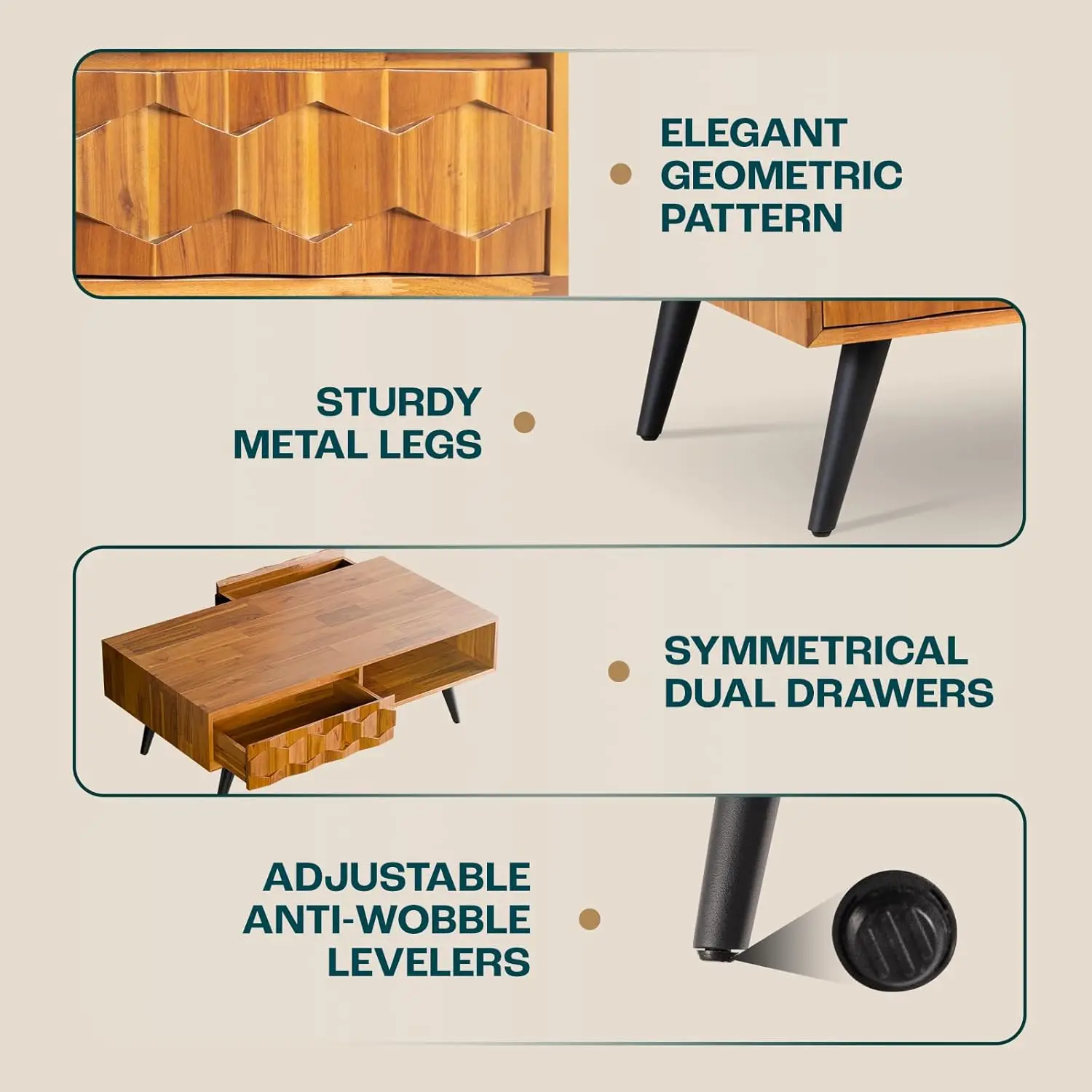
Poor grain alignment creates vulnerable stress points where furniture is most likely to fail. For example, a chair leg with grain running diagonally across it rather than along its length will be significantly weaker and prone to breaking under normal use. Understanding these principles helps you assess the grain direction in furniture before purchase, ensuring you select pieces built to last.
Grain Density: The Key to Teak Furniture Durability
Grain density—how tightly packed the wood fibers are—directly determines how your teak furniture will stand up to daily life and environmental challenges. Dense grain creates a smooth, uniform surface resistant to dents, scratches, and wear that would quickly damage lesser woods.
Higher density means better protection. Tightly packed grain creates fewer entry points for moisture—the primary enemy of wooden furniture. When water cannot easily penetrate the wood structure, the risk of swelling, warping, and decay dramatically decreases. This natural moisture resistance is why quality teak outdoor furniture can last for decades even when exposed to rain and humidity fluctuations.
You can often assess grain density visually by examining how close together the grain lines appear. In premium teak, these lines are narrow and positioned very close to one another with minimal space between them. When you run your hand across high-density teak, you’ll notice a remarkably smooth, almost silky feel that’s distinctly different from lower-quality wood.
Another practical indicator of grain density is weight. Dense-grained teak feels surprisingly heavy for its size—a quality characteristic shared by other premium hardwoods used in mid-century modern walnut coffee tables. This weight comes from the compact cellular structure that gives the wood its exceptional strength.
For furniture that will face heavy use or challenging environments, prioritizing high grain density provides significant long-term benefits in durability and appearance retention.
Teak Grain and Stability: Why Quality Teak Resists Warping
One of teak’s most valuable qualities is its remarkable dimensional stability—its ability to maintain its shape despite humidity and temperature changes. This stability comes directly from its grain structure and natural oil content.
All wood naturally expands and contracts with moisture fluctuations, but quality teak does so minimally and, most importantly, evenly. The straight, consistent grain patterns in premium teak allow it to respond to humidity changes in a uniform way that prevents the internal stresses that cause warping, twisting, and cracking in other woods.
The natural oils distributed throughout teak’s grain structure act as stabilizing agents, moderating how quickly the wood absorbs or releases moisture. This slower, more controlled response to environmental changes helps the furniture maintain its shape even when placed near heating vents, in humid bathrooms, or on covered patios.
This stability advantage is particularly evident when comparing teak to other hardwoods. Woods with similar density but less favorable grain structures often develop problems within just a few seasonal cycles. Quality teak furniture, however, can maintain its perfect form for generations—making it an exceptional value despite its higher initial cost.
When selecting teak furniture, examining grain straightness and consistency gives you insight into how stable the piece will remain throughout its lifetime in your home.
The Aesthetic Impact: How Grain Defines Teak’s Beauty
Beyond structural considerations, teak’s grain patterns create a visual signature that has made it coveted in fine furniture for centuries. The interplay of color, texture, and pattern within quality teak grain creates a warm, inviting presence that few other materials can match.
In premium teak, the grain displays subtle color variations ranging from golden honey to amber, with occasional darker streaks that add character without disrupting the overall harmony. This natural color palette creates a sophisticated yet welcoming aesthetic that complements virtually any design style.
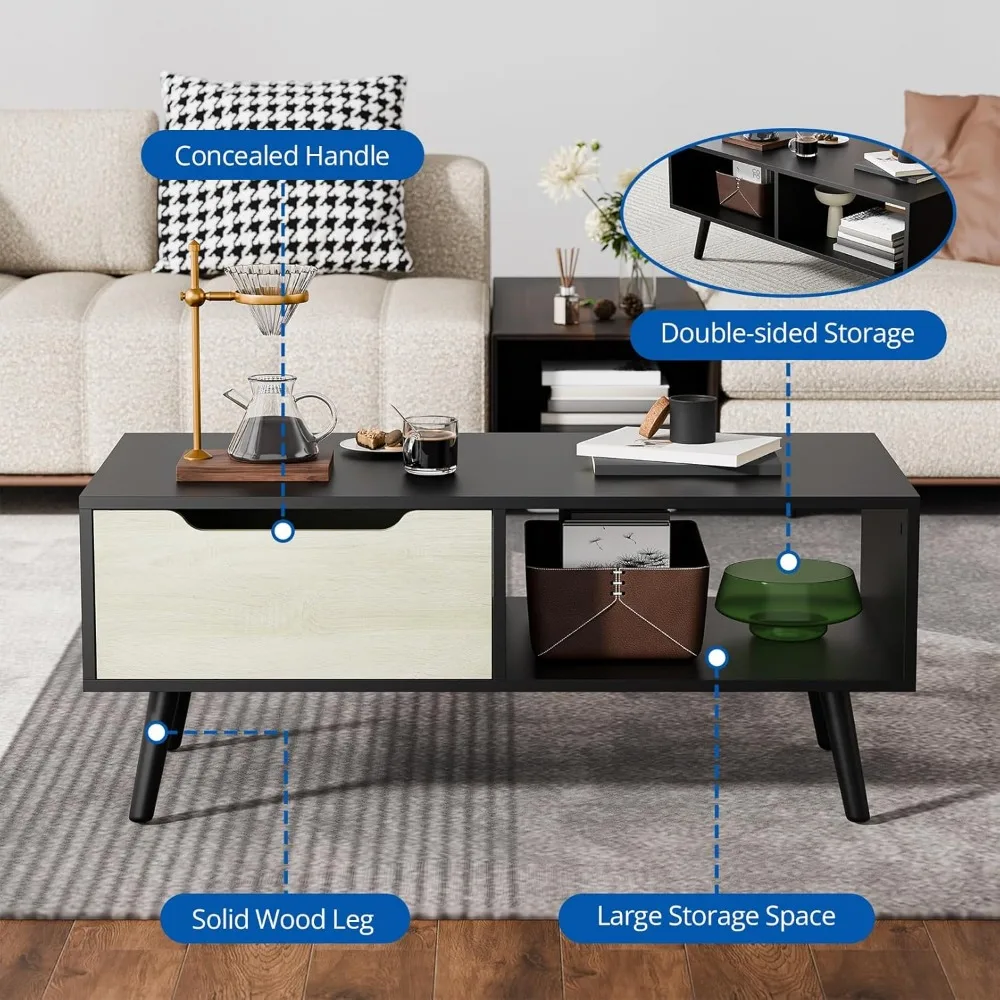
The way light interacts with teak grain creates another dimension of beauty. Quality teak has a natural luster that catches light differently across its surface as the grain changes direction, creating a gentle play of highlights and shadows that brings the wood to life. This subtle visual movement makes teak furniture feel dynamic and organic.
The grain’s texture contributes significantly to both visual and tactile appeal. When properly finished, high-quality teak has an exceptionally smooth feel while still allowing you to sense the natural grain pattern beneath your fingertips. This combination of visual richness and tactile pleasure makes black mid-century coffee table design pieces crafted from quality teak especially satisfying to both see and touch.
Mid-Century Modern Solid Wood Coffee Tables, Mid-Century Modern Teak Coffee Tables
$879.95 Select options This product has multiple variants. The options may be chosen on the product pageMid-Century Modern Danish Coffee Tables, Mid-Century Modern Oval Coffee Tables, Mid-Century Modern Solid Wood Coffee Tables
$390.05 Select options This product has multiple variants. The options may be chosen on the product pageMid-Century Modern Oval Coffee Tables, Mid-Century Modern Solid Wood Coffee Tables
$679.56 Select options This product has multiple variants. The options may be chosen on the product pageMid-Century Modern Solid Wood Coffee Tables, Mid-Century Modern Walnut Coffee Tables
$501.53 Select options This product has multiple variants. The options may be chosen on the product pageMid-Century Modern Round Coffee Tables, Mid-Century Modern Solid Wood Coffee Tables
Price range: $522.31 through $559.78 Select options This product has multiple variants. The options may be chosen on the product pageMid-Century Modern Glass Top Coffee Tables, Mid-Century Modern Large Coffee Tables, Mid-Century Modern Rectangular Coffee Tables, Mid-Century Modern Walnut Coffee Tables
Price range: $559.64 through $618.53 Select options This product has multiple variants. The options may be chosen on the product page
Teak’s distinctive grain characteristics also allow it to harmonize beautifully with other materials. Whether paired with metal, glass, leather, or other woods, teak’s grain creates a natural focal point that enhances the overall design without overwhelming it.
Practical Assessment: How to Evaluate Teak Grain Quality
When shopping for teak furniture, you don’t need to be a wood expert to assess grain quality effectively. These straightforward techniques will help you make informed decisions:
Visual Inspection Techniques
- Look for straight, parallel grain lines with consistent spacing
- Check for uniform color throughout (variations should be subtle)
- Examine joints and edges where grain patterns are most visible
- Minimal knots suggest higher quality (small, tight knots are acceptable)
- Avoid pieces with large open knots, cracks, or extreme grain irregularities
Tactile Assessment
- Run your hand across the surface—quality teak feels smooth with a subtle waxy quality
- Press your fingernail gently against an inconspicuous area—premium teak resists denting
- Quality teak should feel dense and substantial for its size
Red Flags to Watch For
- Excessive waviness or irregular grain patterns
- Numerous large knots or voids in the wood
- Very light color throughout (may indicate sapwood)
- Rough or uneven texture when touched
- Visible glue lines indicating laminated pieces rather than solid teak
For outdoor furniture, pay special attention to grain direction on key structural elements like legs and support members. Straight grain running the length of these components indicates better construction practices.
If possible, look at the underside or back of furniture pieces where less finishing is typically applied. These areas often reveal more about the true grain quality than heavily finished visible surfaces.
These assessment techniques align with professional methods for identifying genuine teak furniture and help ensure your investment will provide lasting beauty and performance.
Common Misconceptions About Teak Grain and Quality
Several persistent myths about teak grain can lead to confusion when evaluating furniture quality. Understanding these misconceptions helps you make more informed decisions:
Myth: All knots indicate poor quality.
Reality: Small, tight knots are natural in even high-grade teak. What matters is their size, number, and placement. Problematic knots are large, loose, or positioned in structural areas where they might affect strength.
Myth: Darker teak is always better quality.
Reality: While heartwood is typically darker than sapwood, color alone doesn’t determine quality. Some excellent teak has a medium golden tone rather than dark brown. Natural color variation is normal and desirable—what matters is consistency within each piece.
Myth: Perfectly straight grain is the only indicator of quality.
Reality: While straight grain is generally desirable, slight variations can add character without compromising quality. Gentle, flowing grain patterns can be perfectly acceptable in premium teak. What you want to avoid is abrupt, irregular grain changes that indicate stress or poor tree growth.
Myth: You need perfect quarter-sawn teak for quality furniture.
Reality: While quarter-sawn cuts (where growth rings are perpendicular to the board’s face) offer excellent stability, flat-sawn teak can also make beautiful, durable furniture when properly dried and constructed.
Myth: All teak furniture is naturally waterproof.
Reality: Teak’s water resistance directly correlates with its grain quality and oil content. Lower-grade teak with less dense grain offers significantly reduced moisture protection compared to premium grades.
These clarifications help put teak quality in perspective, aligning with broader principles of comprehensive guide solid wood furniture selection that emphasize understanding material properties rather than relying on simplified generalizations.
Teak Grain Maintenance: Preserving Quality and Beauty
The unique grain structure of teak requires specific maintenance approaches to preserve its natural beauty and performance. Following these guidelines will help your furniture age gracefully:
Cleaning With the Grain
Always clean teak furniture in the direction of the grain, not against or across it. This prevents dirt from becoming embedded in the grain structure and avoids raising the wood fibers. Use a soft brush or cloth with mild soap and water for routine cleaning.
Understanding Patina Development
Quality teak naturally develops a silvery-gray patina when exposed to sunlight. This process happens gradually and affects the grain differently depending on its density and oil content. This patina is not damage—it’s a protective layer that many teak enthusiasts prize for its elegant appearance.

Oil Application Considerations
If you prefer to maintain teak’s golden color, apply teak-specific oils sparingly and with the grain. Excessive oil can actually trap moisture and dirt in the grain structure. Never use standard furniture polishes or oils not specifically formulated for teak, as these can damage the wood’s natural protective properties.
Protecting Grain Structure
Avoid pressure washing or aggressive scrubbing, which can erode the softer portions of the grain pattern and create an uneven surface. For stubborn stains, gentle sanding with fine-grit sandpaper in the direction of the grain is safer than harsh chemical cleaners.
Seasonal Care
In regions with extreme seasonal changes, indoor humidity control helps preserve teak’s optimal moisture content, preventing the minor expansion and contraction cycles that can gradually affect grain appearance over many years.
With proper care, quality teak furniture often becomes more beautiful with age, developing character while maintaining structural integrity—a rare combination that explains teak’s enduring popularity in fine furniture.
Sustainability and Grain Quality: The Future of Premium Teak
The relationship between sustainable forestry practices and teak grain quality has become increasingly important as demand for this exceptional wood continues. Understanding this connection helps consumers make both environmentally and quality-conscious decisions.
Responsible forest management directly impacts teak grain quality. Trees allowed to mature fully in well-maintained forests develop superior grain structures compared to those harvested prematurely. Certification systems like the Forest Stewardship Council (FSC) help ensure that teak comes from responsibly managed sources where trees reach appropriate maturity before harvesting.
Plantation-grown teak presents both challenges and opportunities for quality furniture. While plantation teak grows more quickly than old-growth forest teak, careful management can still produce excellent grain quality. The best plantation operations allow trees sufficient time to develop heartwood with dense grain and high oil content, though typically harvesting occurs earlier than with traditional forests.
When selecting teak furniture, looking for certification labels provides assurance that your purchase supports responsible forestry while still obtaining quality materials. These sustainable practices ensure that future generations can continue to enjoy the exceptional beauty and performance of well-grown teak.
The principles of quality assessment and sustainability blend seamlessly with modern design approaches that celebrate natural materials, as seen in styling black mid-century coffee table concepts that honor both aesthetic excellence and environmental responsibility.
How Experts Identify Superior Teak Grain (From a Craftsman’s Perspective)
Professional furniture makers rely on generations of accumulated knowledge to select the ideal teak for each project. Their expertise offers valuable insights for anyone evaluating teak furniture:
Master craftsmen begin their assessment by examining the end grain—the cross-section of the wood that reveals the growth ring pattern. Tight, evenly spaced rings indicate slow, stable growth resulting in stronger, more consistent wood. This end-grain inspection reveals information about the tree’s growing conditions that surface grain patterns might not show.
For structural components like table legs or chair frames, experts select quartersawn sections where grain runs perfectly parallel to the piece for maximum strength. For visible surfaces like tabletops, they often choose sections with particularly attractive grain figuring while still maintaining structural integrity.
Grain matching—where adjacent wooden sections have complementary grain patterns—represents another level of craftsmanship. In quality furniture, drawer fronts, table leaves, or cabinet doors will show thoughtfully matched grain that creates visual harmony across the entire piece.
The weight-to-size ratio serves as another professional assessment tool. Experienced woodworkers can immediately tell if a teak sample has appropriate density by simply holding it. This “heft test” quickly reveals if the wood has the cellular density associated with quality teak.
These professional standards align with traditional techniques found in revealing quality craftsmanship vintage furniture, where attention to grain selection and orientation was considered essential rather than optional.
Frequently Asked Questions About Teak Grain
How can I tell if furniture is made from genuine teak by looking at the grain?
Authentic teak has a distinctive straight grain pattern with occasional wavy lines and a golden-brown color. It feels slightly oily to the touch due to natural oils in the wood. Fake teak often has perfectly uniform grain patterns that look artificial or lacks the characteristic natural oil feel.
Does teak grain change appearance over time?
Yes, teak naturally develops a silvery-gray patina when exposed to sunlight. This patina forms more evenly on high-quality grain. The underlying grain structure remains consistent, but the surface color evolves. Regular oil application can maintain the original golden color if preferred.
How does grain pattern affect furniture pricing?
Furniture with straight, consistent grain from the heartwood of mature teak trees commands premium prices because it offers superior durability and appearance. More irregular grain patterns from younger trees or outer portions typically cost less but may not perform as well long-term.
Can I determine teak quality just by color?
Color alone isn’t a definitive indicator. While heartwood typically has a richer golden-brown color compared to the lighter sapwood, color variations exist even in quality teak. Grain consistency and density are more reliable quality indicators than color alone.
How does grain affect teak’s resistance to outdoor conditions?
Tighter, more consistent grain creates fewer entry points for moisture and contains higher concentrations of natural protective oils. This makes furniture with premium grain significantly more resistant to weather damage, decay, and insect infestation than pieces with irregular or loose grain patterns.

